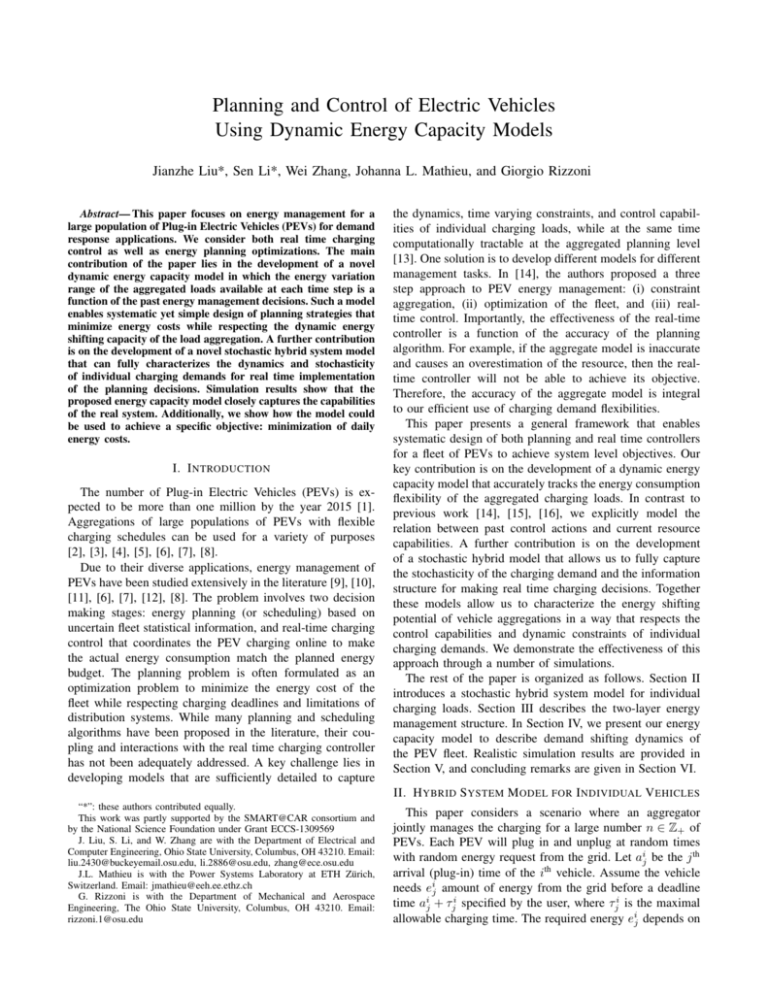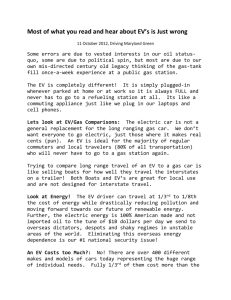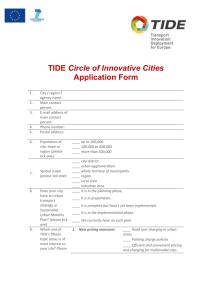Planning and Control of Electric Vehicles Using Dynamic Energy
advertisement

Planning and Control of Electric Vehicles Using Dynamic Energy Capacity Models Jianzhe Liu*, Sen Li*, Wei Zhang, Johanna L. Mathieu, and Giorgio Rizzoni Abstract— This paper focuses on energy management for a large population of Plug-in Electric Vehicles (PEVs) for demand response applications. We consider both real time charging control as well as energy planning optimizations. The main contribution of the paper lies in the development of a novel dynamic energy capacity model in which the energy variation range of the aggregated loads available at each time step is a function of the past energy management decisions. Such a model enables systematic yet simple design of planning strategies that minimize energy costs while respecting the dynamic energy shifting capacity of the load aggregation. A further contribution is on the development of a novel stochastic hybrid system model that can fully characterizes the dynamics and stochasticity of individual charging demands for real time implementation of the planning decisions. Simulation results show that the proposed energy capacity model closely captures the capabilities of the real system. Additionally, we show how the model could be used to achieve a specific objective: minimization of daily energy costs. I. I NTRODUCTION The number of Plug-in Electric Vehicles (PEVs) is expected to be more than one million by the year 2015 [1]. Aggregations of large populations of PEVs with flexible charging schedules can be used for a variety of purposes [2], [3], [4], [5], [6], [7], [8]. Due to their diverse applications, energy management of PEVs have been studied extensively in the literature [9], [10], [11], [6], [7], [12], [8]. The problem involves two decision making stages: energy planning (or scheduling) based on uncertain fleet statistical information, and real-time charging control that coordinates the PEV charging online to make the actual energy consumption match the planned energy budget. The planning problem is often formulated as an optimization problem to minimize the energy cost of the fleet while respecting charging deadlines and limitations of distribution systems. While many planning and scheduling algorithms have been proposed in the literature, their coupling and interactions with the real time charging controller has not been adequately addressed. A key challenge lies in developing models that are sufficiently detailed to capture the dynamics, time varying constraints, and control capabilities of individual charging loads, while at the same time computationally tractable at the aggregated planning level [13]. One solution is to develop different models for different management tasks. In [14], the authors proposed a three step approach to PEV energy management: (i) constraint aggregation, (ii) optimization of the fleet, and (iii) realtime control. Importantly, the effectiveness of the real-time controller is a function of the accuracy of the planning algorithm. For example, if the aggregate model is inaccurate and causes an overestimation of the resource, then the realtime controller will not be able to achieve its objective. Therefore, the accuracy of the aggregate model is integral to our efficient use of charging demand flexibilities. This paper presents a general framework that enables systematic design of both planning and real time controllers for a fleet of PEVs to achieve system level objectives. Our key contribution is on the development of a dynamic energy capacity model that accurately tracks the energy consumption flexibility of the aggregated charging loads. In contrast to previous work [14], [15], [16], we explicitly model the relation between past control actions and current resource capabilities. A further contribution is on the development of a stochastic hybrid model that allows us to fully capture the stochasticity of the charging demand and the information structure for making real time charging decisions. Together these models allow us to characterize the energy shifting potential of vehicle aggregations in a way that respects the control capabilities and dynamic constraints of individual charging demands. We demonstrate the effectiveness of this approach through a number of simulations. The rest of the paper is organized as follows. Section II introduces a stochastic hybrid system model for individual charging loads. Section III describes the two-layer energy management structure. In Section IV, we present our energy capacity model to describe demand shifting dynamics of the PEV fleet. Realistic simulation results are provided in Section V, and concluding remarks are given in Section VI. II. H YBRID S YSTEM M ODEL FOR I NDIVIDUAL V EHICLES “*”: these authors contributed equally. This work was partly supported by the SMART@CAR consortium and by the National Science Foundation under Grant ECCS-1309569 J. Liu, S. Li, and W. Zhang are with the Department of Electrical and Computer Engineering, Ohio State University, Columbus, OH 43210. Email: liu.2430@buckeyemail.osu.edu, li.2886@osu.edu, zhang@ece.osu.edu J.L. Mathieu is with the Power Systems Laboratory at ETH Zürich, Switzerland. Email: jmathieu@eeh.ee.ethz.ch G. Rizzoni is with the Department of Mechanical and Aerospace Engineering, The Ohio State University, Columbus, OH 43210. Email: rizzoni.1@osu.edu This paper considers a scenario where an aggregator jointly manages the charging for a large number n ∈ Z+ of PEVs. Each PEV will plug in and unplug at random times with random energy request from the grid. Let aij be the j th arrival (plug-in) time of the ith vehicle. Assume the vehicle needs eij amount of energy from the grid before a deadline time aij + τji specified by the user, where τji is the maximal allowable charging time. The required energy eij depends on E(k) = Z tk energy y all (t)dt tk−1 Group 4 If planning control sequence is not selected properly, the actual energy consumption E(k) can be quite different from the planned value uE (k). Therefore, the planning decision needs to respect the actual variability of the fleet energy. Let Emax (k) and Emin (k) be the maximum and minimum achievable energy of the closed-loop system trajectory under policy µT (·, ·; pk ) during the k th period, i.e., Z tk Z tk Emax (k) = pmax (t)dt and Emin (k) = pmin (t)dt. tk−1 tk−1 Then the energy planning problem can be formulated as ( PN minuE k=1 L(uE (k)) (4) s.t.: Emin (k) ≤ uE (k) ≤ Emax (k), k = 1, . . . , N where L is an arbitrary cost function of uE (k). The main challenge for solving the above problem lies in the dynamic dependence of Emin and Emax on the control sequence uE . For each given control uE , one can use Monte Carlo simulations of the closed-loop trajectories to compute the actual Emin and Emax ; thus the feasibility of a given control can be checked numerically. However, this approach is not fully scalable, and makes it hard (if not impossible) to find the globally optimal solution. In the next section, we will develop a novel dynamic model to quantify how the energy allocation at step k will affect the energy variation range over later steps. This will transform the energy planning problem to a discrete time optimal control problem, admitting a simple and scalable solution (with respect to the number of PEVs) through dynamic programming. IV. M ODELING D EMAND S HIFTING DYNAMICS FOR E NERGY P LANNING The energy variation range [Emin (k), Emax (k)] has been mostly treated as static in the literature [14], [15], [16]. Our key observation here is that the energy variation range [Emin (k), Emax (k)] depends dynamically on the planning decision uE (k). This phenomenon will be referred to as the demand shifting dynamics. In this section, we will first illustrate the shifting dynamics using a simple example, and then develop a dynamic model to capture the relationship between the variation range and the planning control sequence. A. Simple Illustrating Example For illustration purposes, we consider a simplified scenario, where the current and future charging loads are divided into 4 groups as shown in Fig. 4. The first three groups are already in the system at time 1 while Group 4 will arrive at time 2. The shaded squares in the figure represent the amount of required energy, while the blank squares represent the extra times available for serving the loads. For example, the figure indicates that Group 2 demands 2 units of energy from the grid before time 4. We now compute the Emin and Emax for this simple scenario. Since all the first 3 groups can be deferred for at least 1 time step, we can easily find out that Emin (1) = 0 and Group 3 Group 2 Group 1 t s Fig. 4. t u v w time Illustration of demand shifting dynamics. Emax (1) = 3. Suppose we choose a feasible energy budget for time step 1 as uE (1) = 0. This implies all three groups will be postponed by 1 time step. Therefore, at time step 2, Group 1 and Group 3 can no longer be deferred, indicating that Emin (2) = 2 and Emax (2) = 4. However, if we choose uE (1) = 3 at time step 1, then at time step 2, Group 3 is completed while Group 1 and Group 2 can still be deferred, indicating that Emin (2) = 0 and Emax (2) = 3. Based on the above discussion, the relationship between energy variation range and the planning control sequences is dynamic and depends on the states of all the PEVs2 . Since the evolution of the states is rather complex, the exact and complete characterization of the demand shifting dynamics can be computationally intensive. To enable real world applications, a simple yet effective means to capture the shifting dynamics is desirable. B. Dynamics of Emin We first derive the dynamics of Emin (k). For each k ≤ N , let d(k) be the energy consumption of the fleet in period k under the condition that the last minute charging strategy is applied from time 1 to time k. The sequence d(k) can be estimated accurately at the beginning of the entire planning horizon through simulations. Referring again to the example in the last subsection, [d(1), . . . , d(5)] = [0, 2, 2, 3, 1]. It is easy to verify that the sequence d(k) is not a lower bound for feasible control uE (k), but it does provide a lower bound in terms of its partial sum. Therefore, it is often possible Pk to have uE (k)P<k d(k) for a general k > 1. However, be satisfied m=1 uE (m) ≤ m=1 d(m) must Pk for all k = 1, . . . , N . At step k, the quantity m=1 uE (m)− Pk m=1 d(m) represents the extra load completed as compared to the last minute charging strategy. This extra amount will reduce the minimum required energy for step k + 1 or later. Therefore, an estimated value of Emin (k), denoted by Êmin (k), after applying the energy allocation sequence uE (1), . . . , uE (k), is given by ( Êmin (k)=max 0, d(k)− k−1 X m=1 uE (m)− k−1 X m=1 d(m) !) (5) 2 It is worth mentioning that the effect of demand shifting dynamics typically does not decrease as the population size increases. 2500 The dynamics of Emax can be analyzed similarly. We define b(k) as the energy consumption of the fleet in period k under the condition that the immediate charging strategy is applied from time 1 to time k. Similar to d(k), the sequence b(k) can be determined offline through simulations. Notice that uE (k) ≥ b(k) for some k > 1, but Pk it is possible to Phave k u (m) ≤ b(m) must be satisfied for all k ≥ E m=1 m=1 Pk Pk 1. The net difference m=1 b(m)− m=1 uE (m) represents the total postponed energy up to time k as compared with the immediate charging case. Unfortunately, the idea used for deriving Emin does not apply to Emax since the total postponed energy at k does not directly add up to that of the next step Emax (k + 1). Due to this complication, simple analyical expression as in (5) is not available for Emax . Fortunately, the dynamics of Emax do not exhibit strong nonlinearity as in (5). We propose a simple linear function to approximate its relation with uE ! k−1 k−1 X X uE (m) + βk̂ , (6) b(m) − Êmax (k) = αk̂ 2000 m=1 m=1 where k̂ denotes the relative time step with respect to the beginning of the current day. For example, if the planning starts at 12pm of Day 2 with ∆t = 0.5 hour. Then k = 10 will result in k̂ = 12/0.5 + 10 = 34. In this way, the coefficient vectors α and β will both have 24/∆t elements. Notice that for a large number of PEVs their daily energy demand is very similar over different days. To estimate α and β, we can generate a large number of random uE over a multi-day period and simulate the corresponding Emax sequence. The data can be used to calculate the coefficients α and β in (6) using a standard least squares approach. A key feature of the model is that once the coefficients are identified, the aggregator can keep using the same model for making planning decisions regardless of the actual starting time of the planning horizon. D. Application to Planning Decision Making With the models for Emin and Emax , we can transform the planning problem (4) to an optimal controlPproblem with k−1 a simple dynamic constraint. Define z(k) = m=1 uE (m), for k = 2, . . . , N , with z(1) = 0. The problem (4) can be solved through the following deterministic optimal control problem N X L(uE (k)) (7) min uE k=1 subject to: z(k + 1) = z(k) P + uE (k) k−1 uE (k) ≤ αk̂ b(m) − z(k) + βk̂ n m=1 o u (k) ≥ max 0, d(k)− z(k)− Pk−1 d(m) E (8) m=1 Notice that the dynamic constraint (8) is only 1-dimensional with a state-dependent nonlinear control constraint. This problem can be efficiently solved using dynamic programming. Power (kW) C. Dynamics of Emax Real Emin Estimated Emin Real Emax Estimated Emax uE 1500 1000 Real Power 500 0 0 2 4 6 8 10 12 14 16 18 20 22 24 Time (Hours) Fig. 5. Illustration of the estimated and real Emin and Emax . The sequence uE is randomly generated between its . dynamic range V. S IMULATION In this section, we will validate the proposed model of Emin and Emax and show its application in a realistic energy planning problem. The charging profile of a fleet involving 2,000 PEVs will be simulated. The fleet data used in the simulation can be found in [20]. Notice that more realistic driving pattern data can be easily incorporated into our simulation. A. Model Validation for Demand Shifting Dynamics We first validate the accuracy of Êmin and Êmax in our model. In this simulation, we consider the case where N = 24 hours and ∆t = 1 hour. At the beginning of the planning horizon, the last minute and immediate charging demand profile (d(·) and b(·)) can be estimated based on historical data. Since Êmin = d(1) and Êmax = b(1), we generate uE (1) randomly within the range [d(1), b(1)]. This uE (1) in return allows us to compute Êmin (2) and Êmax (2) based on (5) and (6). Continuing with this process, we can obtain a control sequence uE (k) and the corresponding real time charging policy µT (·, ·; pk ). The real energy consumption E(k) and the real Emin (k) and Emax (k) are shown in Fig. 5 in comparison with the planned energy budget uE (k) as well as the estimated Êmin (k) and Êmax (k). It can be seen that the real energy follows the planned energy very closely. One can also see that the Emin and Emax are estimated accurately. It is worth pointing out that the above validation is done in an open-loop sense for which the model did not refer to the true values of Emin and Emax throughout the entire planning horizon. Since the model can accurately capture the demand shifting dynamics it can be used for energy planning over a relatively large planning horizon (e.g., a day). B. Energy Planning Application In this section, we apply the models of Emin and Emax to a day ahead energy planning problem, in which we aim to minimize the cost of energy over a day. We consider a planning horizon of 24 hours, starting from 12PM on August 1, 2013 to 12PM on August 2, 2013. The real LMP (Locational Marginal Price) during this 24 hour period is obtained from the PJM website [21]. To evaluate the optimal planning decision, we choose the immediate charging policy as the baseline. To ensure a fair comparison, we impose an additional constraint that the total Baseline Optimal Energy Price 150 1000 100 500 50 0 0 Fig. 6. 2 4 6 8 Energy Price($/MWh) Load(kWh) 1500 0 10 12 14 16 18 20 22 24 Time(Hours) Results of energy planning problem under real LMPs from PJM . charging P24 energy must P24be the same as the baseline. That is, i=1 uE (i) = i=1 b(i). Denote the energy price as P r = [P r(1), P r(2), ..., P r(24)], the charging cost can be minimized by solving the following optimization problem using(dynamic programming: P24 minuE k=1 P r(k) · uE (k) P24 P24 subject to: (8) and i=1 uE (i) = i=1 b(i) The simulation results are shown in Fig. 6. Our optimal charging policy defers the loads when energy prices are high and charges the loads when they are low. For the obtained optimal solution, the energy cost of charging the fleet is reduced by almost 52%. Moreover, this energy planning decision is verified through closed-loop simulations under the real time tracking policy uT (·, ·; pk ). The result shows the energy budget is followed accurately. VI. CONCLUSION In this paper, we presented two models that allow us to coordinate aggregations of electric vehicles to achieve common objectives. The proposed stochastic hybrid system model can effectively capture the dynamics of individual charging loads for real time charging control, while the dynamic energy capacity model accurately estimates the demand shifting dynamics of aggregations of PEVs by explicitly modeling the effect of past control actions on current resource capabilities. Using these models, we are able to efficiently coordinate vehicles to achieve objectives like minimizing daily energy costs while respecting the dynamic constraints and control capabilities of individual vehicles. Simulations showed the effectiveness of the approach. Future research will investigate the use of this approach to achieve objectives such as energy balancing and frequency support. R EFERENCES [1] P. Davis, “U.S. Department of Energy Vehicle Technologies Program Overview,” Mar. 2011. [Online]. Available: http://www1.eere.energy.gov/vehiclesandfuels [2] S. Han, S. Han, and K. Sezaki, “Development of an optimal vehicleto-grid aggregator for frequency regulation,” Smart Grid, IEEE Transactions on, vol. 1, no. 1, pp. 65–72, 2010. [3] M. Galus, S. Koch, and G. Andersson, “Provision of load frequency control by PHEVs, controllable loads, and a cogeneration unit,” Industrial Electronics, IEEE Transactions on, vol. 58, no. 10, pp. 4568–4582, 2011. [4] P. Denholm, M. Kuss, and R. Margolis, “Co-benefits of large scale plug-in hybrid electric vehicle and solar PV deployment,” Journal of Power Sources, vol. 236, pp. 350 –356, 2013. [Online]. Available: http://www.sciencedirect.com/science/article/pii/S0378775312015534 [5] C. Quinn, D. Zimmerle, and T. Bradley, “An evaluation of stateof-charge limitations and actuation signal energy content on plugin hybrid electric vehicle, vehicle-to-grid reliability, and economics,” Smart Grid, IEEE Transactions on, vol. 3, no. 1, pp. 483–491, 2012. [6] Z. Ma, D. Callaway, and I. Hiskens, “Decentralized charging control for large populations of plug-in electric vehicles,” in Decision and Control (CDC), 2010 49th IEEE Conference on. IEEE, 2010, pp. 206–212. [7] K. Mets, T. Verschueren, W. Haerick, C. Develder, and F. Turck, “Optimizing smart energy control strategies for plug-in hybrid electric vehicle charging,” in Network Operations and Management Symposium Workshops (NOMS Wksps), 2010 IEEE/IFIP. IEEE, 2010, pp. 293–299. [8] P. Kulshrestha, L. Wang, M. Chow, and S. Lukic, “Intelligent energy management system simulator for phevs at municipal parking deck in a smart grid environment,” in Power & Energy Society General Meeting, 2009. PES’09. IEEE. IEEE, 2009, pp. 1–6. [9] M. Tamor, C. Gearhart, and C. Soto, “A statistical approach to estimating acceptance of electric vehicles and electrification of personal transportation,” Transportation Research Part C: Emerging Technologies, vol. 26, pp. 125–134, 2013. [10] T. Lee, Z. Bareket, T. Gordon, and Z. Filipi, “Stochastic modeling for studies of real-world PHEV usage: Driving schedule and daily temporal distributions,” Vehicular Technology, IEEE Transactions on, vol. 61, no. 4, pp. 1493–1502, 2012. [11] K. Valentine, W. Temple, and K. Zhang, “Intelligent electric vehicle charging: Rethinking the valley-fill,” Journal of Power Sources, vol. 196, no. 24, pp. 10 717–10 726, 2011. [12] Q. Gong, S. Midlam-Mohler, V. Marano, and G. Rizzoni, “Study of pev charging on residential distribution transformer life,” Smart Grid, IEEE Transactions on, vol. 3, no. 1, pp. 404–412, 2012. [13] D. Callaway and I. Hiskens, “Achieving controllability of electric loads,” Proceedings of the IEEE, vol. 99, no. 1, pp. 184–199, 2011. [14] S. Vandael, B. Claessens, M. Hommelberg, T. Holvoet, and G. Deconinck, “A scalable three-step approach for demand side management of plug-in hybrid vehicles,” 2012. [15] O. Sundstrom and C. Binding, “Flexible charging optimization for electric vehicles considering distribution grid constraints,” Smart Grid, IEEE Transactions on, vol. 3, no. 1, pp. 26–37, 2012. [16] M. Galus, R. Waraich, and G. Andersson, “On the interdependence of intelligent charging approaches for plug-in electric vehicles in transmission and distribution networks,” in Innovative Smart Grid Technologies (ISGT Europe), 2012 3rd IEEE PES International Conference and Exhibition on. IEEE, 2012, pp. 1–8. [17] P. J. Ramadge and W. M. Wonham, “The control of discrete event systems,” Proceedings of the IEEE, vol. 77, no. 1, pp. 81–98, 1989. [18] J. Hu, J. Lygeros, and S. Sastry, “Towards a theory of stochastic hybrid systems,” in Hybrid Systems: Computation and Control. Springer Verlag, 2000, no. 1790, pp. 160–173. [19] M. L. Bujorianu and J. Lygeros, “General stochastic hybrid systems: Modelling and optimal control,” in IEEE Conference on Decision and Control, vol. 2, 2004, pp. 1872–1877. [20] D. Guo, W. Zhang, G. Yan, Z. Lin, and M. Fu, “Decentralized control of aggregated loads for demand response,” in Proceedings of the American Control Conference, Washington, DC, June 2013. [21] PJM, “Monthly locational market price.” [Online]. Available: http://www.pjm.com/markets-and-operations/energy/realtime/monthlylmp.aspx







